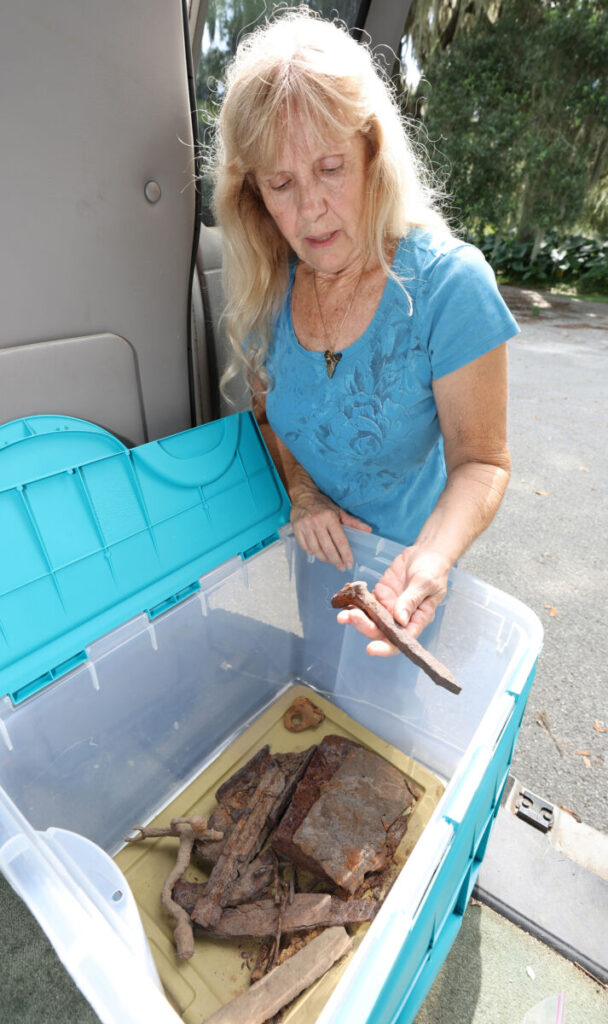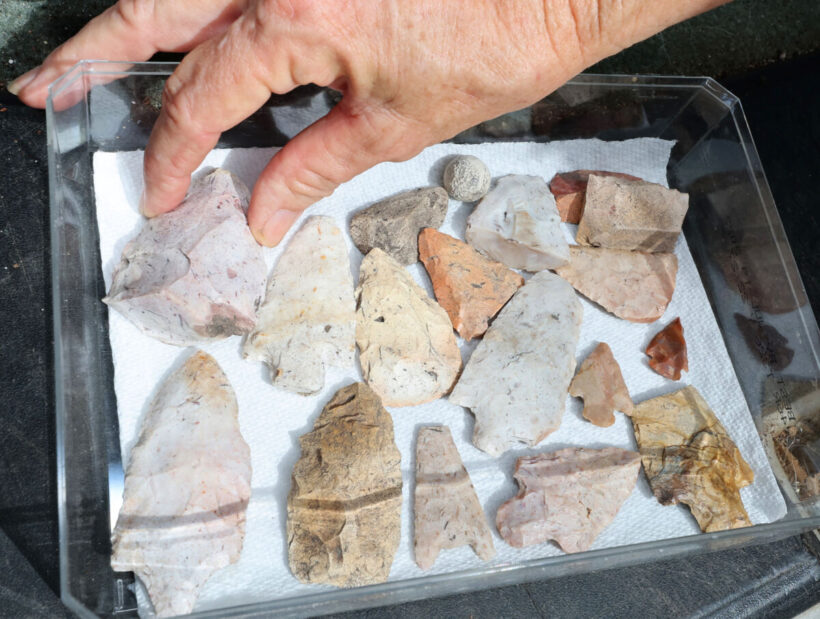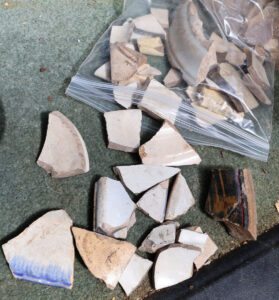Mysterious Fort Drane
Just before the start of the Second Seminole Indian War in 1885, the U.S. Army established an outpost on a 3,000-acre plantation north of Ocala, named Fort Drane. The location has been narrowed down, but remains an enigma.

Sabrina Jarema holds a railroad spike, as she talks about an old ax head, horse yoke, a blade and other historical items she found on her property off County Road 329 north of Ocala on Sunday, July 24, 2022. [Bruce Ackerman/Ocala Gazette] 2022.
That soon changed.
Shortly after the professional fantasy illustrator and author moved to her 40-acre spread, she started finding artifacts, some from several thousand years ago and others from the 1835-42 war period.
“At first I started finding arrowheads and shards just lying on the ground in one of my pastures,” said Jarema. “Then I started finding various pieces of pottery, China, and old glass in another area.”
A New York City native, Jarema also discovered musket balls and metal objects, including old axe handles, and remnants of bayonets or swords near a large spring on yet another part of her land. One of her dogs even dug up an old horse bit while a good friend found old railroad spikes using a metal detector one day.
“He kept getting hits all along my back fence and pulled out a few of them before he stopped digging,” said Jarema, awarding-winning author of the “Viking Lords” series of books from Kensington Publishing.
She also found an old well, on the edge of a property line she shares with a local mining company, SCI Materials LLC, which leases the land from Palmer Resources, LLC, formerly Mid-Florida Mining.
Talk about paydirt.
Her farm, Jarema later learned, was once part of the massive Auld Lang Syne sugar mill plantation of Col. Duncan L. Clinch, a four-square mile swath of land nestled between present-day county roads 318, 225 and 329 near the hamlets of Fairfield and Irvine, north of Ocala.
The site later would serve as a strategic outpost where Army soldiers, Native Americans and others lived and, in many cases, died from wounds and sickness. The farmland, however, is shrouded in mystery as repeated efforts over time to locate the exact parameters of the military fort and the graves of those buried there have had mixed results.
Today, the area, located in the county’s Farmland Preservation Area, is poised to undergo a transformation that could forever erase its history. In June, the Marion County Board of County Commissioners, in a 3-to-2 vote, approved plans to build the World Equestrian Center (WEC) Jockey Club development on nearby land, which was also part of the Auld Lang Syne plantation.
In July, several neighbors of the property, along with local farmland conservation group Save Our Rural Lands, filed a lawsuit appealing the approval and requested a formal administrative hearing challenging the amendments to the county’s comprehensive plan, which allowed the rezoning of the property and subsequent approval of the project. That hearing is scheduled for Oct. 5-6 in Ocala.
Fort Drane Established
Just before the start of the Second Seminole Indian War, which officially began in December 1885 following the ambush and massacre of Col. Francis Dade and his troops near present-day Bushnell, and the same-day killing of Indian Agent Wiley Thompson and Lt. Constantine Smith at Fort King in Ocala, the U.S. Army established an outpost on the 3,000-acre plantation and it was renamed Fort Drane.
Soldiers constructed a walled 150-by-80-yard fort encompassing the crude plantation buildings, with blockhouses on two sides along with several other buildings. The fort eventually became the Army’s headquarters, housing several thousand soldiers while also offering a haven to hundreds of homesteaders, slaves, and Native American refugees.
It served as a critical base for military attacks against the Seminoles along the Withlacoochee River, too, according to Joe Knetsh, Ph.D., a retired research historian for the State of Florida and a noted expert on the Seminole Indian Wars.
Skirmishes between soldiers and Seminole warriors took place on the plantation and along military trails leading from Fort King, Micanopy, and other outposts in the area. Ambushes of supply trains and messengers were common, too; the Native Americans were extremely adept at guerilla warfare.
Her homestead’s storied past far surpasses a casual interest for Jerema, who grew up in Fort Lauderdale and raises Arabian horses and AKC registered white German Shepherds on her farm.
“I have a very strong sense of the history that took place here,” she said. “It’s one of the things I love about this property, and I’d like to know more about it.”
She nearly got the chance.
Roughly 15 or so years ago, members of a local historical society visited Jarema’s farm, bearing metal detectors and a strong desire to trace the movement of Army troops during the war.
“They told me an officer (Clinch) had owned my land and had camped his troops in the area and they wanted to find out just where they were and to look for artifacts,” she said. “They brought me a bucket full of stuff they’d found later that day.”
Jarema soon gave the group written permission to conduct an archaeological dig or survey of her land to find evidence of the Army’s occupation and Clinch’s plantation.
“I sent the paperwork in but never heard back from them,” she said.
What Happened To The Fort?
By January 1837, Fort Drane had been abandoned and its buildings and the sugar mill were subsequently burned down by Seminoles. But during its brief existence on the tortuous Florida frontier, it also served as a hospital for the wounded and dying.
While many enlisted men died from battle wounds, others passed away from diseases such as yellow fever and malaria, and a sickness dubbed, “country fever.”
As many as five soldiers died each day from the latter, according to John Bemrose, an Englishman who served as a medic at Fort Drane and who wrote about his experiences in a book, “Reminiscences of the Second Seminole War.” All were buried on the property, along with the civilians, slaves, and Native Americans who also perished there.

Sabrina Jarema shows Native American arrowheads, points and a musket ball she found on her property off County Road 329 north of Ocala on Sunday, July 24, 2022. [Bruce Ackerman/Ocala Gazette] 2022.
The mine property was at one time part of the vast land holdings of the late State Sen. L.K. Edwards Jr., and it was acquired by the late Whit Palmer Jr. in 1977, who purchased it from Allen Edgar, founder of Mid-Florida Mining.
Palmer, an Ocala native who died in 2020, began mining the property for its clay soil and soon became one of the U.S.’s top cat litter producers.
In the mid-to-late 1980s, members of the now-defunct Friends of Fort Drane and the Marion County Historical Society, along with the still-in-existence Micanopy Historical Society, led by the late Alyce Tincher, began an earnest search for the fort and soon zeroed in on the mine property, with help and direction from Lonnie K. Edwards III, the son of the late state senator.
Edwards, now in his 80s, detailed childhood forays and picnics to the site for a Gazette story, “What Happened to Fort Drane,” published in June. It was high on a hill with rolling pastureland and grandfather oaks.
“I remember the footings or foundations of not just one but multiple buildings there,” Edwards said for the story. He never saw any human remains or burial sites but was told they were on the property.”
The historical group’s goal was to get the historically significant site recognized and possibly preserved by local and state officials.
Subsurface Examination
The June story detailed troubling allegations by two former mine employees that Palmer Jr., and his son, Martin Palmer, mine manager, in January 1991 ordered human remains unearthed during mining operations, including human skulls with teeth in them. Those as well as remnants of the fort and other artifacts were ordered dumped into a 50-foot-deep pit elsewhere on the property.
The accusations were made in sworn statements taken from the former employees, Dana Hughes and Thomas L. Reaves, in August 1991 by Tincher’s group. Both men are deceased.
Human remains are protected under Florida law, which requires anyone finding them to immediately contact local law enforcement for investigation. It is not illegal for a property owner to remove artifacts.
In December 1991, following “strong urging” from staff at the Division of Historical Resources, who had been notified by Tincher and others of the allegations, the Palmers hired Gainesville-based archeological firm SouthArc to conduct a sub-surface examination of an area of the mine.
The firm was searching for evidence of Second Seminole Indian War period remains but, by then, if the claims are true, it was much too late as nearly a year had gone by since the graves had allegedly been dug up.
“They desecrated the remains and destroyed evidence of the fort,” said Jeffrey Winans, who served in the U.S. Army Reserve for six years, from 1968-74 and is appalled by the alleged treatment of the dead soldiers and Native American remains.
The 75-year-old wrote a book, “What Happened to Fort Drane in Marion County,” in the mid-1990s based on his research and experiences while involved in the effort to save the fort.
In a copy of the SouthArc survey recently obtained by the Gazette, the firm reported finding no evidence of human remains, but their team did uncover numerous artifacts, mainly bottle glass and ceramics, which they believed were from Clinch’s plantation as well as a later farm.
The firm also found the remains of one burnt structure, “that could have been a blockhouse”, according to the survey.
However, in a letter to state archaeologist Jim Miller that accompanied the survey report, SouthArc said the artifacts and features it had found could not be definitely tied to the Second Seminole Indian War period, “although we suspect that one feature could have been associated with the military construction.”
“The lack of metal artifacts may indicate heavy exploitation of the site by collectors with metal detectors,” the March 1992 letter said.
The survey report itself states that the lack of evidence of burials is difficult to explain if the features were actually a part of Fort Drane.
“Burials could be located at some distance from the Fort compound, possibly within the adjacent property to the north of Mid-Florida Mining,” said the report.
The former Ocala Jockey Club, now known as the WEC Jockey Club, is located on County Road 318, directly north of the mine.
Development vs. Adverse Impacts
While SouthArc’s survey produced no evidence of burials, wealthy amateur archeologist Clarence Moore in 1878 donated the remains of a Native American to the Harvard University-affiliated Peabody Museum of Archaeology and Ethnology, which in its documentation said the individual was killed in 1836 at Fort Drane by U.S. troops under the command of Lt. Col. F.K. Pearce.
Knetsch, who has written extensively about the war and became close friends with Tincher after she contacted him in 1987 seeking help to save the old fort, told the Gazette for its June article that he took little stock in SouthArc’s findings and believes the fort was at the mine site.
No digging or excavation was done during the survey – only plowing and subsurface examination of the area was conducted.
Thirty-plus years after the attempt to get the Fort recognized, , its name resurfaced in an April letter from the Department of State, Division of Historical Resources, which prompted the Gazette’s June story.
The letter was sent to the Marion County Board of County Commissioners in response to a mandated review by state agencies of the proposed amendment to its comprehensive plan, which in turn would allow development of the WEC Jockey Club.
The state’s letter noted the numerous cultural resources recorded in the general vicinity of the 1,029-acre property and that there had been multiple attempts to locate a potential historical site known as Fort Drane, which is thought to contain human remains in the immediate area.
The letter said development should be sensitive to locating, assessing, and avoiding adverse impacts to any resources.
Scott Mitchell, director of the Silver River Museum and Environmental Education Center at Silver Springs State Park, declined to speak directly about the WEC Jockey Club project and Fort Drane, but he noted a common policy that exists when dealing with archaeological sites.
“In a general sense, it’s considered to be sound public policy and science to try to identify historically significant sites prior to development, especially when you’re dealing with unmarked graves,” said Mitchell.
“This way, they can be appropriately studied and recorded so that appropriate actions can be taken,” he said.

Sabrina Jarema shows fragments of historical pottery and dishes she found on her property off County Road 329 north of Ocala on Sunday, July 24, 2022. [Bruce Ackerman/Ocala Gazette] 2022.
Mitchell noted that the Division of Historical Resources has very clear rules on archaeological sites and said there have been many cases in Florida where sites have been appropriately researched and then eventually cleared for development.
“It can be a muddy situation, with lots of different interests and criteria to look at,” he said. “It’s sound science and sound planning to at least understand what you have, with the understanding that your determination may not make people happy.”
Robert Rosa, an officer with the Central Florida chapter of the American Indian Movement (AIM) and of Borinquen Taino nation descent, said Marion County has a responsibility to try and locate the fort site, and any burials associated with it.
“From a historical perspective from both sides–Native Americans and the people of Florida–there should be a more detailed search for Fort Drane,” said Rosa.
“I know Fort Drane’s location has been narrowed down several times,” he said. “But it just seems like the politicians have had a hand in getting it buried.”
Still A Mystery
Meanwhile, Jarema still doesn’t know the full extent of the role her 40-acre plot played in the Second Seminole Indian War. She has never conducted any concerted search or dig of her property. The artifacts she has found over the years, and still finds today, are usually lying on top of the ground after heavy rains.
Based on research she conducted on the glass, pottery, and China she discovered on her farm, Jarema said the latter’s pattern matches what Army officers used during the war. Most of the arrowheads discovered on her property can be traced to ancient Native American tribes.
“I know my land was part of the plantation, but since it’s never been looked at and surveyed by an archaeologist, no one really knows what’s out there just beneath the earth,” said Jarema.
“It’s very exciting to think about,” she said.





